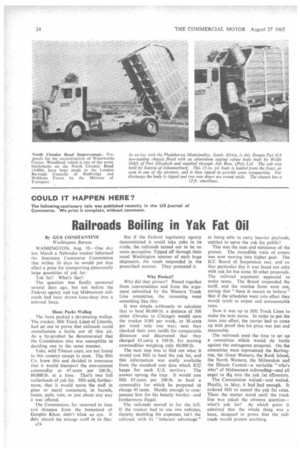Railroads Boiling in Yak Fat Oil
Page 26

If you've noticed an error in this article please click here to report it so we can fix it.
By GUS CONSTANTINE Washington Bureau
WASHINGTON, Aug. 10.—One day last March a Nebraska trucker informed he Interstate Commerce Commission that within 30 days he would put into effect a price for transporting abnormally large quantities of yak fat..
Yak fat? What's that?
The question was finally answered several days ago, but not before the Federal agency and top Midwestern railroads had been drawn knee-deep into a colossal hoax.
Hoax Packs Wallop
The hoax packed a devastating wallop. The trucker, Hilt Truck Lines of Lincoln, had set out to prove that railroads could manufacture a battle out of thin air. As a by-product he demonstrated that the Commission also was susceptible to deciding one in the same manner.
Yaks, wild Tibetan oxen, are not found in this country except in zoos. The Hilt Co. knew this and decided to announce that it would transport the non-existent commodity at 45 cents per 100 lb., 80,000 lb. at a time. That's two full trailerloads of yak fat. Hilt said, furthermore, that it would move the stuff in glass or metal containers, in barrels, boxes, pails, tubs, or just about any way it was offered.
The Commission, far removed in time and distance from the homeland of Genghis Khan, didn't blink an eye. It duly placed the strange tariff in its files.
A24 But if the Federal regulatory agency demonstrated it could take yaks in its stride, the railroads turned out to be no more perceptive. Tipped off through their usual Washington sources of such huge shipments, the roads responded in the prescribed manner. They protested it.
Why Protest?
Why did they protest? Pieced together from conversations and from the argument submitted by the Western Trunk Line committee, the reasoning went something like this:
It was simple arithmetic to calculate that to haul 80,000 lb. a distance of 500 miles (Omaha to Chicago) would earn the trucker $180 per truck, or 36 cents per truck mile one way; next they checked their own tariffs for comparable distances and discovered that they charged 62 cents a 100 lb. for moving commodities weighing only 60,000 lb.
The next step was to find out what it would cost Hilt to haul the yak fat, and this information was easily available from the standard cost data which ICC keeps for each U.S. territory. The answer sprung the trap. It would cost Hilt 63 cents per 100 lb. to haul a commodity for which he proposed to charge 45 cents. Hardly enough to compensate him for his beastly burden—and furthermore illegal.
The railroads moved in for the kill. If the trucker had to use two vehicles, thereby doubling his expenses, isn't the railroad. with its " inherent advantage" in being able to carry heavier payloads, entitled to serve the yak fat public?
This was the sum and substance of the protest. The incredible train of events was now moving into higher gear. The ICC Board of Suspension met, and on that particular day it was faced not only with yak fat but some 30 other proposals, The railroad argument appeared to make sense. The Board suspended the tariff, and the routine form went out, stating that " there is reason to believe" that if the schedules went into effect they would result in unjust and unreasonable rates.
Now it was up to Hilt Truck Lines to make the next move. In order to put the rates into effect, the carrier had to come up with proof that his price was just and reasonable.
The railroads used the time to set up a committee which would do battle against the outrageous proposal. On the committee were represented the Burlington, the Great Western, the Rock Island, the North Western, the Milwaukee and the Illinois Central—a veritable "who's who" of Midwestern railroading—and all eager to dig into the yak fat effrontery.
The Commission waited—and waited. Finally, in May, it had had enough. It ordered Hilt to cancel the yak fat rates. There the matter stood until the truck line was asked the obvious question— what's yak fat? At which point it admitted that the whole thing was a hoax, designed to prove that the railroads would protest anything.












































































































